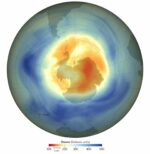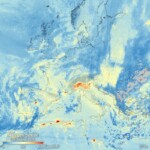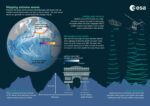
Tuesday, December 2nd, 2025
While continental in scale, the ozone hole over the Antarctic was small in 2025 compared to previous years and remains on track to recover later this century, NASA and the National Oceanic and Atmospheric Administration (NOAA) reported. The hole this year was the fifth smallest since 1992, the year a landmark international agreement to phase

Tuesday, November 11th, 2025
Across the world’s oceans, including U.S. territorial waters, some vessels deliberately “go dark,” switching off AIS (cooperative beacon) to operate undetected. These actions can mask illegal fishing, pollution or non-compliant operations, posing risks to maritime safety, fair competition and environmental security. With its constellation of 17 satellites, Unseenlabs detects radiofrequency (RF) emissions from ships’ onboard electronics, enabling

Tuesday, October 28th, 2025
The new Copernicus Sentinel-4 mission has delivered its first images, highlighting concentrations of atmospheric nitrogen dioxide, sulphur dioxide and ozone. Despite being preliminary, these images mark a major milestone in the ability to monitor air quality all the way from geostationary orbit, 36,000 kilometers above Earth. This image depicts tropospheric nitrogen dioxide with clear pollution hotspots visible

Sunday, October 12th, 2025
Driven by wind, waves are at their most powerful during storms, yet the greatest threat to coastlines often does not come from the storm itself, but from the long swells that carry wave energy far beyond the storm’s reach. These long waves radiate across oceans, and their properties—such as wave period, or the time between

Friday, September 26th, 2025
On the left we see a high-resolution HySpex image of the Puch test area in true colors, taken on May 12, 2025. In the center is the same image with locations of drone acquisition points (orange). And on the right, land cover derived from EnMAP satellite data. Pixel colors denote photosynthetically active (“live”) vegetation in

Monday, September 15th, 2025
MetOp Second Generation (MetOp-SG) was launched in August 2025. Two of its instruments have already returned first data. Now it’s the turn of the Multiviewing multichannel multipolarisation imager (3MI), which was built by Leonardo and provides data on aerosols in our atmosphere. The first images captured by 3MI are a view over Northern Africa, Italy and the eastern Mediterranean,

Tuesday, September 2nd, 2025
LYNRED supplied three of the four critical detectors onboard the METOP-SG weather satellite, which was launched from Kuru, French Guyana, on Aug. 12, 2025. The satellite will orbit the Earth pole-to-pole to deliver near real-time data on the state of our atmosphere, resulting in more accurate forecasts, better disaster preparedness and a sharper view of the

Wednesday, August 13th, 2025
Advanced Navigation successfully demonstrated a breakthrough in underground navigation, delivering high-precision positioning without reliance on fixed infrastructure or GNSS, in Europe’s deepest underground mine in Pyhäjärvi, Finland. The Hybrid Navigation System, combining a Laser Velocity Sensor with the Boreas D90 fiber-optic gyroscope Inertial Navigation System, achieved consistent sub-0.1 percent navigation error across multiple runs, without relying

Wednesday, August 6th, 2025
Forests play a central role in the global carbon cycle as trees store carbon in their trunks, branches, roots and leaves. However, climate change and human activities can change the ability of forests to absorb carbon and the annual changes in these carbon stocks are highly variable in space and time around the globe. That’s

Tuesday, July 22nd, 2025
The National Oceanic and Atmospheric Administration’s (NOAA) Space Weather Follow On–Lagrange 1 (SWFO-L1) Observatory, set to provide quicker and more accurate space weather forecasts, arrived Sunday, July 20, 2025, at the Astrotech Space Operations Facility near NASA’s Kennedy Space Center in Florida. The SWFO-L1 mission will monitor the Sun and near-Earth environment using a suite
